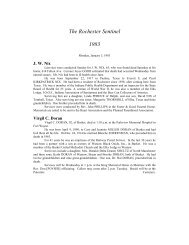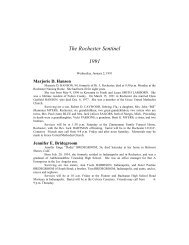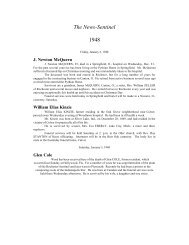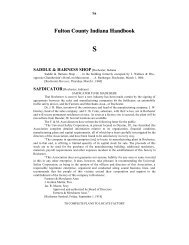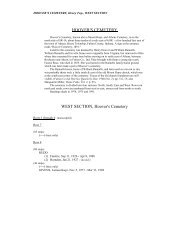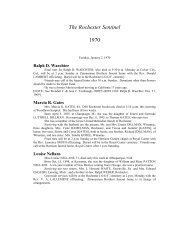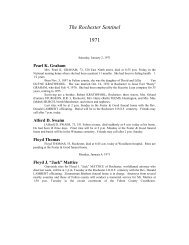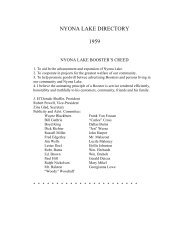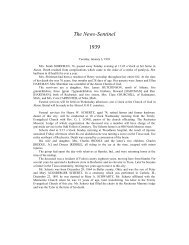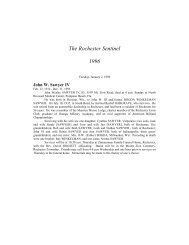Handbook N-P - Fulton County Public Library
Handbook N-P - Fulton County Public Library
Handbook N-P - Fulton County Public Library
You also want an ePaper? Increase the reach of your titles
YUMPU automatically turns print PDFs into web optimized ePapers that Google loves.
Pa<br />
“For every dollar they took from me, I will take ten thousand dollars from Rochester in<br />
the way of wages,” was the statement made by Charles Vanderwater, Erie section man, this<br />
morning. Vanderwater was arrested for intoxication, Saturday night, and though denying his guilt,<br />
declares he paid his fine like a gentleman in order not to raise trouble.<br />
He says that he is the inventor of a new concrete or cement railroad tie, which in time<br />
will be adopted by all railroads because of its efficiency and durability, and that he has made<br />
samples of the tie which were favorably commented upon by a number of railroad companies. He<br />
said he had been asked if he would take $80,000 for the patent, but refused as he thinks it is worth<br />
more. Two companies, among which are the Erie and Wabash and have asked to use the tie, [sic]<br />
but the contract has not been signed because of a disagreement as to the location of the factory.<br />
Mr. Vanderwater wished very much to locate the factory in Rochester, because of the<br />
excellent quality of the gravel here, and was holding out for that reason. He said this morning that<br />
after that treatment he received in Rochester, he would rather lose his patent than see Rochester<br />
benefit by it.<br />
The tie he claims to have invented is in three pieces, consisting of the tie proper and the<br />
parts used in holding the track to it. According to his statement, he has tested the tie for three<br />
months on his section at Akron.<br />
[Rochester Sentinel, Tuesday, April 15, 1913]<br />
“NON-SKIDDABLE” AUTO INVENTED<br />
A device which may bring him a fortune is now being perfected by G.P. Keith, well<br />
known ex-druggist, who has invented several other things of considerable promise. Mr. Keith’s<br />
newest production is a “non-skiddable” automobile.<br />
When seen today, he refused to talk of his work, saying that he had not even applied for a<br />
patent on it, and would not do so until he has a model ready. He declared that any kind of an auto<br />
may use the attachment and added that it had nothing whatever to do with tires, any kind of which,<br />
he declared, might be used with his device.<br />
He stated that he was certain that his invention would work, and told the Sentinel reporter<br />
that he could convince him he was right, in half an hour’s time. However he refused to explain the<br />
principle of his invention.<br />
May Mean Fortune<br />
If Mr. Keith has really solved the problem which has so long bothered motortists, he has<br />
a comfortable fortune in view. Details will be announced as soon as the patent is secured.<br />
Mr. Keith has worked out a number of other interesting devices, among them being a<br />
railway crossing which seemed a success, but which was never pushed. He also aided in<br />
perfecting the Miller fire escape, which was at one time manufactured here and which later proved<br />
not to be in demand.<br />
[Rochester Sentinel, Thursday, May 1, 1913]<br />
O. HAGEN INVENTS MOTOR SLED<br />
Otis Hagen, local motorcycle racer and agent for the Harley Davidson machine, has made<br />
the first motor sled ever seen in this city or perhaps in the whole state.<br />
People on the street Saturday were startled when the contrivance made its appearance. At<br />
first it is hard to understand how the machine is propelled. The sled runners are about four inches<br />
high with a road clearance in front of about eight inches. The engine taken off of a motorcucle, is<br />
placed in front and the drive leads to a motorcycle wheel in the center of the sled. The wheel is<br />
wrapped with chain to prevent skidding, and is fixed between supports, the handles of which are<br />
held by the driver. If he wants more speed he bears down on the wheel and if he sees an<br />
obstruction in the road, he can lift the wheel clear off of the ground. The machine is guided with<br />
the feet.<br />
Hagan said that his machine is capable of making 25 miles an hour. Many people have<br />
read of motor sleds in tales of Arctic exploration where they have proved a success. The local man




